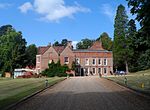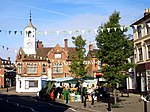Flitwick railway station
AmpthillDfT Category D stationsFlitwickFormer Midland Railway stationsPages with no open date in Infobox station ... and 5 more
Railway stations in BedfordshireRailway stations in Great Britain opened in 1870Railway stations served by Govia Thameslink RailwayUse British English from March 2015Vague or ambiguous time from November 2023

Flitwick railway station is in the centre of Flitwick, in Bedfordshire, England. The station is situated on the Midland Main Line. The station is managed by Thameslink, who operate all trains serving it, and is served by Thameslink route services between Bedford and Brighton. As well as Flitwick itself, the station also serves the adjoining town of Ampthill, which no longer has its own station. From Flitwick, trains travel north and serve Bedford and southbound trains serve Luton, Luton Airport Parkway, Harpenden, St Albans, London St Pancras, Gatwick Airport and Brighton.
Excerpt from the Wikipedia article Flitwick railway station (License: CC BY-SA 3.0, Authors, Images).Flitwick railway station
High Street,
Geographical coordinates (GPS) Address Nearby Places Show on map
Geographical coordinates (GPS)
| Latitude | Longitude |
|---|---|
| N 52.004 ° | E -0.495 ° |
Address
Flitwick
High Street
MK45 1DP
England, United Kingdom
Open on Google Maps







